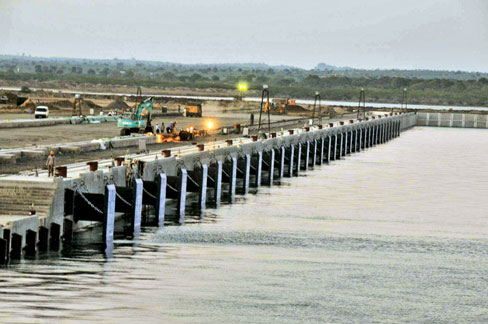H'tota port to anchor first ship in November
by Lalin FERNANDOPULLE
The Hambantota port which changed the Sri Lankan map and placed the
country in a strategic location for seafaring will anchor its first ship
by mid next month, said Chief Engineer, Hambantota Port Project, Agil
Hewageegana.
He said that the first phase of the port which will be completed
early next month is ahead of schedule. The project was scheduled to be
completed in the first half of 2011.
 |
|
The Hambantota port |
"Fenders have been fixed and the final touches are being put to
complete the first phase of the port. The port will be able to berth
four vessels on completion of the first phase", Hewageegana said.
The Hambantota port, one of the largest and deepest in the region
will help relieve pressure on the Colombo port and provide services to
ships on route.
Hewageegana said the Hambantota port being located close to the
east-west shipping routes has a distinct advantage to attract large
vessels and be a major hub port in the region.
The new port will take away a major load of the port activities in
Colombo which mainly caters to container handling.
The Hambantota port will provide facilities for port related
industries and services such as bunkering, maintenance, logistics,
buying provisions and medical supplies.
The first phase of the port will consist of two 600m general purpose
berths, a 310m bunkering berth and a 120m small craft berth. The first
phase will also contain a bunkering facility and a farm which will
comprise of eight tanks for marine fuel, three for aviation and three
for liquid petroleum gas.
Hewageegana said that a 15 floor administrative complex will be built
as a part of the project. The Hambantota port will operate initially as
an industrial and service port and then as a commercial port.
The mouth of the harbour has a 22m depth. When completed the port
will have a 1.5 km long breakwater with a minimum basin depth of 17m.
The Colombo port has a depth of 15.5 metres.
A dam will be built to prevent flooding in the surrounding areas and
a seawall made of interlocking concrete blocks will protect the port
from high seas.
Hambantota which is one of the poorest regions in the country will
benefit enormously from the new port that will provide around 5,000
direct and around 50,000 indirect employment to people in the areas.
Promotion of tourism, agricultural and industrial growth, rise in
land value and creation of a vibrant export sector are some of the main
benefits of the port.
"The new port which will provide the much needed foreign currency to
the country and be a major challenge to ports in the region", he said.
"The Sri Lanka Ports Authority has signed the MoU for the second
phase of the project and the agreement will be signed following Cabinet
approval", Hewageegana said.
The investment for the first phase of the port is estimated to be
around US$ 361 million. The cost of the second phase is being
negotiated.
The second phase of the project is expected to be completed within
three years and when completed it could berth around 10 ships.
Sri Lanka is situated along the major shipping routes between the
Malacca Straits and the Suez Canal which links Asia and Europe. An
estimated 36,000 ships including 4,500 oil tankers use the route
annually and daily around 200 vessels pass the southern sea of Sri
Lanka.
The second phase of the port will include a container terminal and
the third phase a dockyard. Upon completion the port will cover 4,000
acres of land and accommodate around 30 vessels.
The Hambantota port is constructed by the China Harbour Engineering
Company.
|

